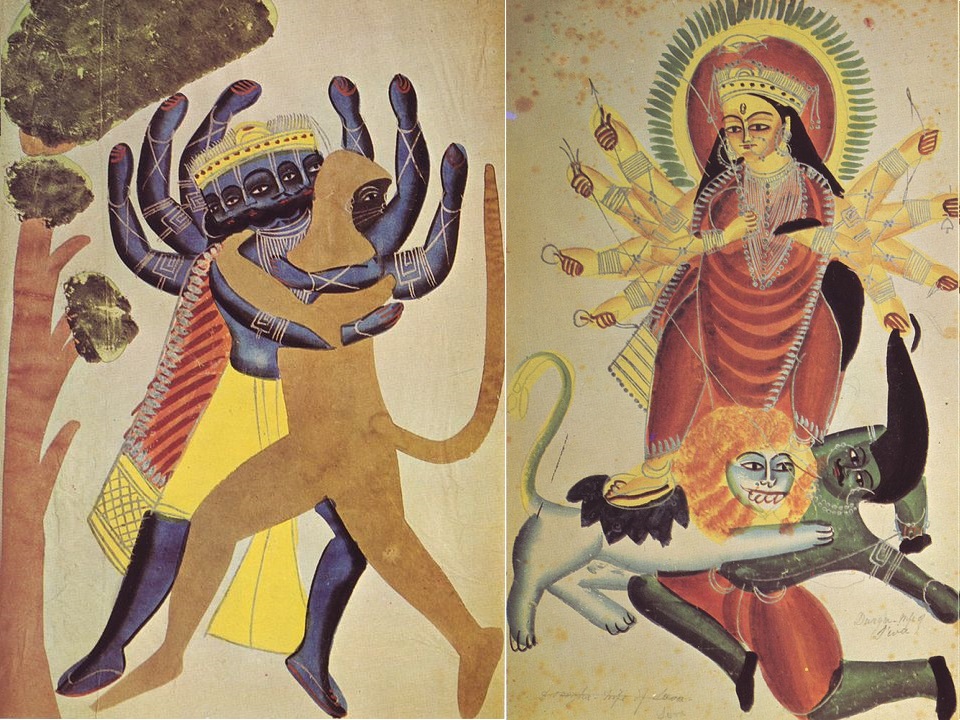

Kalighat painting or Kalighat Pat originated in the 19th century Bengal, in the vicinity of Kalighat Kali Temple, Kalighat, Kolkata, India, and from being items of souvenir taken by the visitors to the Kali temple, the paintings over a period of time developed as a distinct school of Indian painting. From the depiction of Hindu gods, god, and other mythological characters, the Kalighat paintings developed to reflect a variety of themes.
History
In the nineteenth century, the only school of painting that was flourishing in Bengal was the traditional art of scroll paintings that was popular in the rural areas. These paintings were done on cloth or patas. They depicted conventional images of gods and goddesses and scenes from epics like Tulsidas’ Rama charita manas. The artists were villagers who travelled from place to place with their scroll paintings and sang the scenes from the epics depicted in the paintings during village gatherings and various festivals. These artists, called patuas or ‘painters on cloth’ were said to be half Hindu and half Muslim and practised Islam.
The British: as patrons of this art
Meanwhile, the British, having established themselves in the country politically started to evince interest in art, literature, and music. They set up institutions that imparted a European style of academic training to Indian artists. The Calcutta School of Art was one such school and attracted traditional artists–the patuas—to the city. Initially these artists were concentrated around the temple at Kalighat where there was a demand for religious art. Gradually, they started to learn from the newer techniques and discovered that these could help them increase their earnings. They started creating new forms of art and the Kalighat painting was born.
Oriental and Occidental Kalighat
The Kalighat School was an agreeable and unique blend of two different styles of painting—the Oriental and the Occidental—and steadily gained popularity. Among the deities that the Kalighat artists painted, the goddess Kali was a favorite. Images of Durga, Lakshmi, and Annapurna were also popular, especially during the Durga Puja festival. The artists also portrayed themes like Sita-Rama, Radha-Krishna and the exploits of Hanuman. Another theme depicted, dear to the Bengali ethos, was that of Chaitanya Mahaprabhu and his disciples. But the Kalighat artists did not restrict themselves to religious themes. Their paintings depicting different professions and costumes were also popular with the tourists. Even contemporary events like crime were the subject of many paintings. The artists also chose to portray secular themes and personalities and in the process played a role in the Independence movement. They painted heroic characters like Tipu Sultan and Rani Lakshmibai.
Capturing Daily Life
An important achievement of the Kalighat artistes was that they made simple paintings and drawings, which could easily be reproduced by lithography. Such prints were then hand coloured. This trend continued up to the early part of the twentieth century and these paintings ended up in museums and private collections. The charm of the Kalighat paintings lies in the fact that they captured the essence of daily life and they influence modern artistes like the late Jamini Roy even to this day.
The Kalighat-style paintings or drawings were made on paper, and the artists who dedicated themselves to making these drawings were called “patuas” (traditional Bengal painters who traveled from town to village with rolls of paper they had painted and they unfolded as the story was sung to the inhabitants). The paintings were sold around the famous Khaligat temple, between the nineteenth and early twentieth centuries .
The date of when this style was born is not known exactly, but for the type of paper used and the first paintings bought by Europeans, it is possible to conclude that it had to begin shortly after the construction of the current temple in the 1930s of the nineteenth century.
Between 1880 and 1890 , aedas drawings were very popular and most of those that can be seen in museums are more or less of this time.
Presence at Museums
The museum that has the largest number of drawings of this type is the Victory and Albert Museum of London, constituting the largest collection in the world of these paintings, a total of 645 originals.
In addition, the Bodleian Library of Oxford has 110; the Gurasaday Museum, Calcutta, 70; the Pushkin Museum in Moscow, 62, and the Museum of Archeology and Anthropology of the University of Philadelphia, 57; and you can still find other museums, spread around the world, that have small collections of these watercolors.
Source from Wikipedia